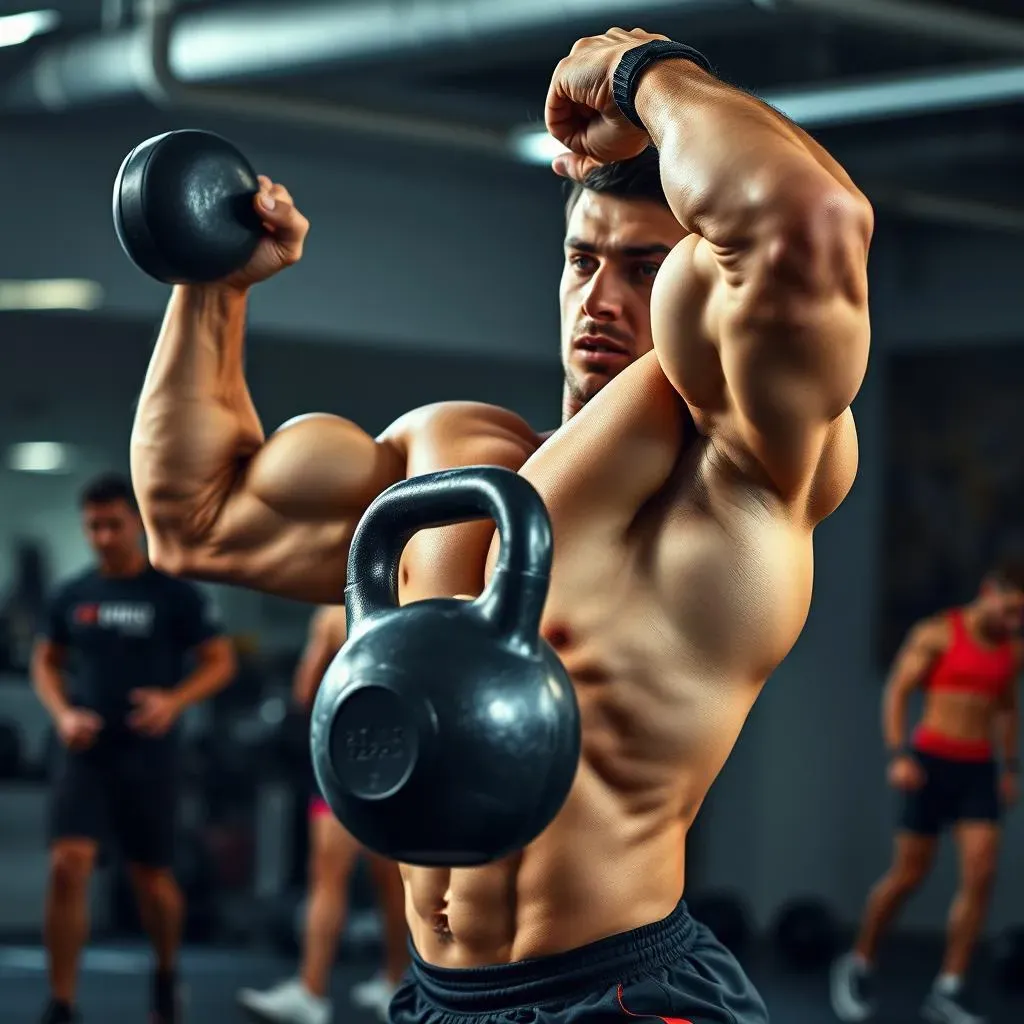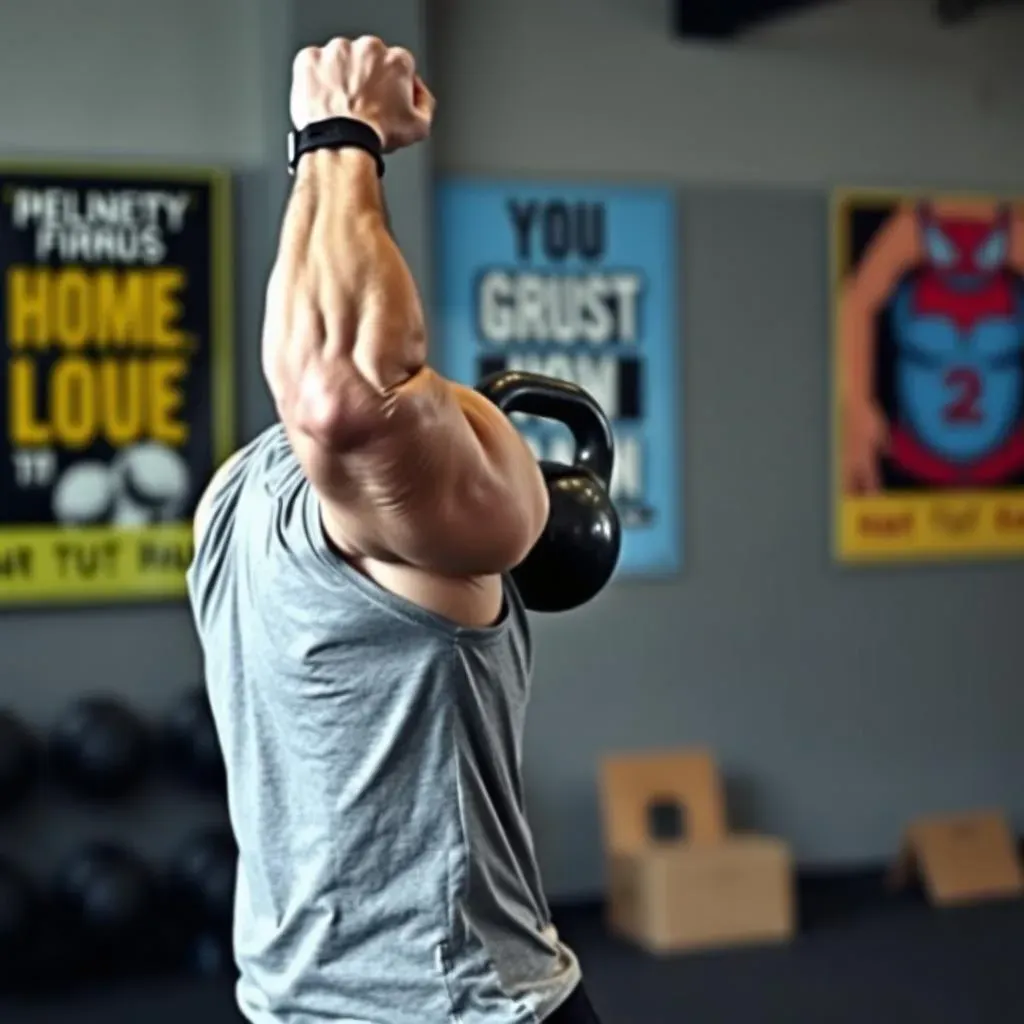Table of Contents
Ready to ditch the dumbbells and unlock serious upper body strength? If you're looking for a dynamic and efficient way to build muscle, torch calories, and improve overall fitness, then a full upper body kettlebell workout is your answer. Kettlebells offer a unique training stimulus that challenges your muscles in ways traditional weights can't, leading to impressive gains in strength, power, and endurance. Forget those endless bicep curls – we're talking about functional movements that translate to real-world strength. This isn't just another list of exercises. We'll dive into why kettlebells are superior for upper body training, covering ten must-do exercises that target every major muscle group. You'll learn how to design your own workout routine, focusing on proper form and gradual progression to avoid injury. Plus, we'll explore advanced techniques to keep your training fresh and challenging. Get ready to swing, press, and snatch your way to a stronger, more resilient upper body. Let’s get started!
Why Kettlebells Dominate for a Full Upper Body Workout

Why Kettlebells Dominate for a Full Upper Body Workout
#1: Asymmetrical Advantage
Kettlebells aren't just another pretty piece of gym equipment; they're a game-changer when it comes to upper body training. One of the biggest reasons why kettlebells dominate for a full upper body workout is their offset center of gravity. Unlike dumbbells, where the weight is evenly distributed, kettlebells force your body to work harder to stabilize and control the load. This asymmetrical loading recruits more muscles, especially in your core and shoulders, leading to greater strength gains and improved stability.
Think about it: when you're doing a kettlebell press, your shoulder muscles are firing on all cylinders to keep the weight from tipping over. This constant engagement builds functional strength that translates to everyday activities, whether you're carrying groceries, lifting luggage, or just trying to maintain good posture. It is not just lifting weight, it is also a core workout.
#2: Grip Strength and Forearm Power
Ever notice how your hands and forearms are burning after a kettlebell workout? That's because kettlebells demand serious grip strength. The thick handle and dynamic movements require you to constantly grip and regrip, strengthening your hands, wrists, and forearms in the process. This is especially beneficial for exercises like kettlebell swings, cleans, and snatches, where a strong grip is essential for both performance and safety.
A strong grip isn't just about lifting heavier weights; it's also crucial for overall health and longevity. Studies have shown a correlation between grip strength and various health outcomes, including reduced risk of heart disease and improved cognitive function. So, by incorporating kettlebells into your upper body routine, you're not just building muscle; you're also investing in your long-term well-being.
#3: Full-Body Integration for Maximum Results
While we're focusing on the upper body, it's important to remember that kettlebell training is rarely isolated. Many kettlebell exercises, such as the clean and press, snatch, and Turkish get-up, require full-body coordination and engagement. This means you're not just working your shoulders, chest, and arms; you're also activating your core, legs, and back, leading to a more comprehensive and effective workout. This full-body integration is a key reason why kettlebells dominate for a full upper body workout.
This integration translates to better athletic performance, improved functional movement, and increased calorie expenditure. By engaging multiple muscle groups simultaneously, you're burning more calories and building a more balanced and resilient physique. It's a win-win situation. If you're short on time and want maximum results, kettlebells are your best bet.
10 Killer Kettlebell Exercises for a Full Upper Body Workout

10 Killer Kettlebell Exercises for a Full Upper Body Workout
Alright, let's get to the good stuff – the exercises! If you're serious about building a powerful upper body with kettlebells, these 10 killer kettlebell exercises are non-negotiable. We're talking about movements that will challenge your strength, stability, and coordination, all while torching calories. Forget endless sets of bicep curls; these exercises are about functional strength and real-world power. Get ready to swing, press, and pull your way to a stronger, more resilient upper body. Each exercise is selected to target specific muscles and movement patterns, ensuring a comprehensive and effective workout.
Before we dive in, remember that proper form is paramount. Start with lighter weights and focus on mastering the technique before progressing to heavier loads. Listen to your body, and don't be afraid to modify exercises as needed. With that said, let's get started!
Crafting Your Full Upper Body Kettlebell Workout Routine

Crafting Your Full Upper Body Kettlebell Workout Routine
#1: Defining Your Goals and Assessing Your Level
So, you're ready to start crafting your full upper body kettlebell workout routine? Awesome! First things first, let's get clear on what you want to achieve. Are you looking to build muscle, increase strength, improve endurance, or simply get a great workout? Your goals will dictate the exercises you choose, the number of sets and reps you perform, and the frequency of your workouts. Be honest with yourself. Knowing what you want makes it easier to get it.
Next up, assess your current fitness level. Are you a complete beginner, or do you have some experience with kettlebells or other forms of strength training? If you're new to kettlebells, start with lighter weights and focus on mastering the fundamental movements before progressing to more challenging exercises. It's always better to start slow and build a solid foundation than to rush into things and risk injury. The kettlebell should be challenging, but not to the point where you loose control.
#2: Selecting the Right Exercises
Now that you've defined your goals and assessed your level, it's time to choose the exercises that will make up your workout routine. Remember those 10 killer kettlebell exercises we talked about earlier? Those are a great starting point. Select a mix of exercises that target all the major muscle groups in your upper body, including your shoulders, chest, back, arms, and core. Variety is key to preventing plateaus and keeping things interesting.
When selecting exercises, consider your individual strengths and weaknesses. If you have weak shoulders, focus on exercises that strengthen your rotator cuffs and improve shoulder stability. If you're lacking in grip strength, incorporate exercises that challenge your hands and forearms. Tailor your workout to address your specific needs and limitations. Don't be afraid to experiment and find what works best for you. You can always adjust your routine as you progress and your body adapts.
#3: Structuring Your Workout and Determining Sets/Reps
Alright, you've got your exercises picked out, now how do you put it all together? When crafting your full upper body kettlebell workout routine, you'll want to think about the order of exercises, the number of sets and reps you'll perform, and the amount of rest you'll take between sets. There are several different ways to structure your workout, depending on your goals and preferences.
One popular approach is to perform exercises in a circuit, moving from one exercise to the next with minimal rest. This is a great way to build endurance and burn calories. Another approach is to focus on one exercise at a time, performing multiple sets with rest in between. This is a good way to build strength and muscle mass. As for sets and reps, a good starting point is 3 sets of 8-12 reps for most exercises. Adjust the weight as needed to challenge yourself while maintaining good form. Rest for 60-90 seconds between sets.
Workout Structure | Description | Benefits |
|---|---|---|
Circuit Training | Perform exercises back-to-back with minimal rest | Builds endurance, burns calories |
Straight Sets | Perform multiple sets of one exercise with rest in between | Builds strength, increases muscle mass |
Kettlebell Workout: Form, Progression, and Injury Prevention

Kettlebell Workout: Form, Progression, and Injury Prevention
Mastering the Fundamentals: Form is King
Let's be real, kettlebells can be intimidating. All that swinging and jerking can look like an accident waiting to happen. That's why mastering proper form is absolutely crucial before you even think about adding weight. Think of it like building a house: you need a solid foundation before you can start adding walls and a roof. With kettlebells, that foundation is impeccable technique. This is especially important to Kettlebell Workout: Form, Progression, and Injury Prevention.
Each exercise has key points to focus on. For example, during a kettlebell swing, it's all about the hip hinge, not squatting. Your back should stay straight, and the power should come from your glutes and hamstrings, not your lower back. Pay attention to your body and listen to what it's telling you. If something feels off, stop and reassess your form. Don't be afraid to film yourself and compare your technique to videos of experienced kettlebell instructors. Your body will thank you later.
Progressive Overload: Gradual and Consistent
Once you've nailed the fundamentals, it's time to think about progression. But hold on, we're not talking about jumping from a 12kg kettlebell to a 24kg overnight. Progressive overload is the name of the game, and it's all about gradually increasing the demands on your body over time. This could mean adding weight, increasing reps, or decreasing rest time. The key is to do it consistently and sustainably.
Don't let your ego get in the way. It's better to progress slowly and maintain good form than to rush into things and risk injury. Track your progress and celebrate your successes, no matter how small they may seem. Remember, it's a marathon, not a sprint. Keep pushing yourself, but always listen to your body and respect its limits. This is key to making sure you're following good Kettlebell Workout: Form, Progression, and Injury Prevention.
Injury Prevention: Listen to Your Body and Respect Your Limits
Injuries are a buzzkill, plain and simple. They can sideline you for weeks, months, or even longer, derailing your progress and leaving you feeling frustrated and defeated. That's why injury prevention should be a top priority in your kettlebell training. The most important thing you can do is listen to your body. Pay attention to any aches, pains, or discomfort, and don't ignore them. If something doesn't feel right, stop and address it before it turns into a bigger problem.
Warm up properly before each workout, and cool down afterwards. Use proper form, and don't try to lift more weight than you can handle. Get enough sleep, eat a healthy diet, and manage your stress levels. All of these things play a role in injury prevention. If you're new to kettlebells, consider working with a qualified instructor who can teach you proper technique and help you design a safe and effective workout program. Also, don't be afraid to take rest days when you need them. Your body needs time to recover and rebuild. This is the final key to Kettlebell Workout: Form, Progression, and Injury Prevention.
Injury Prevention Tip | Description |
|---|---|
Listen to Your Body | Pay attention to aches, pains, and discomfort, and don't ignore them. |
Warm-Up & Cool-Down | Prepare your body for exercise and help it recover afterwards. |
Proper Form | Use correct technique to minimize the risk of injury. |
Adequate Rest | Give your body time to recover and rebuild. |
Beyond the Basics: Level Up Your Full Upper Body Kettlebell Training

Beyond the Basics: Level Up Your Full Upper Body Kettlebell Training
So, you've mastered the basics and you're feeling like a kettlebell pro? Awesome! But don't get complacent, because the world of kettlebell training is vast and there's always room to grow. It's time to move Beyond the Basics: Level Up Your Full Upper Body Kettlebell Training. We're talking about advanced techniques, challenging variations, and strategies to push your limits and unlock even greater strength and performance. This isn't just about lifting heavier weights; it's about refining your technique, exploring new movements, and becoming a true master of the kettlebell.
Ready to take your training to the next level? Let's dive in!
#1: Embrace the Chaos: Unilateral and Offset Loading
Remember how we talked about the asymmetrical nature of kettlebells being a good thing? Well, let's crank that up to eleven! Unilateral exercises, where you're only working one side of your body at a time, are a fantastic way to challenge your stability, coordination, and core strength. Think single-arm kettlebell presses, rows, and carries. The offset load forces your body to work overtime to maintain balance and control, leading to greater muscle activation and improved functional strength.
You can also experiment with offset loading by using different weights in each hand. This is a sneaky way to increase the challenge without necessarily increasing the overall weight. Just be sure to start with a manageable difference and gradually increase it as you get stronger. It's not about ego lifting; it's about challenging your body in new and interesting ways.
#2: Time Under Tension: Slow and Controlled Movements
We're often told to focus on lifting heavy weights, but sometimes, it's not about how much you lift, but how you lift it. Time under tension (TUT) refers to the amount of time your muscles are under stress during an exercise. By slowing down your movements and focusing on controlled contractions, you can significantly increase the intensity of your workout and stimulate greater muscle growth.
Try performing your kettlebell presses, rows, or squats with a slow, deliberate tempo. Focus on squeezing your muscles at the peak of the contraction and resisting the weight as you lower it back down. You'll be surprised at how much harder the exercise feels, even with the same weight. This technique is especially effective for targeting specific muscle groups and improving muscle endurance. Remember, it's not about rushing through the reps; it's about maximizing the time your muscles are working.
#3: Kettlebell Complexes: Flowing Movements for Maximum Burn
Want to take your kettlebell training to the next level? Try incorporating kettlebell complexes into your routine. A complex is a series of exercises performed back-to-back with the same kettlebell, without setting it down. This is a fantastic way to build strength, endurance, and coordination, all while torching calories. Plus, it's a lot more fun than doing endless sets of the same exercise.
You can create your own complexes by stringing together different kettlebell exercises, such as swings, cleans, presses, squats, and lunges. The possibilities are endless! Start with a simple complex of 3-4 exercises and gradually increase the number of exercises as you get more comfortable. Focus on maintaining good form throughout the entire complex, and don't be afraid to modify exercises as needed. Complexes are a great way to challenge your body and mind, and they'll leave you feeling like a total badass.
Complex Variation | Description | Benefits |
|---|---|---|
The Basic Kettlebell Complex | KB Swing, KB Clean, KB Press, KB Squat | Full body strength, endurance, coordination |
The Upper Body Complex | KB Clean, KB Press, KB Row, KB Bicep Curl | Upper body strength, muscle mass |
#4: Master the Turkish Get-Up: The Ultimate Test of Strength and Stability
The Turkish Get-Up (TGU) is often hailed as the king of kettlebell exercises, and for good reason. It's a complex, full-body movement that requires strength, stability, coordination, and mental focus. The TGU involves transitioning from a lying position to a standing position while holding a kettlebell overhead. It's a challenging exercise, but it's also incredibly rewarding. By mastering the TGU, you'll not only build incredible strength and stability, but you'll also improve your overall movement quality and body awareness.
The TGU is a complex movement that requires practice and patience. Start with a light weight and focus on mastering each step of the exercise before progressing to heavier loads. Pay attention to your body and listen to what it's telling you. If something feels off, stop and reassess your form. The TGU is a journey, not a destination. Enjoy the process, and celebrate your progress along the way.
Conclusion: Swing into a Stronger You with Kettlebells
So, there you have it – a comprehensive guide to crafting your own full upper body kettlebell workout. From understanding the unique benefits of kettlebell training to mastering essential exercises and building a personalized routine, you're now equipped to transform your upper body strength and overall fitness. Remember, consistency and proper form are key. Listen to your body, gradually increase the intensity, and don't be afraid to experiment to find what works best for you. Embrace the challenge, enjoy the process, and get ready to swing your way to a stronger, more powerful you. Now go crush those kettlebell workouts!